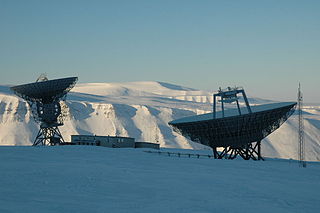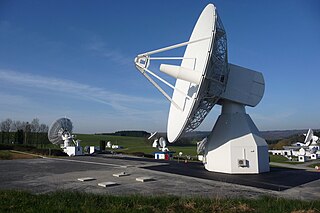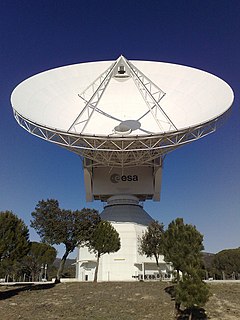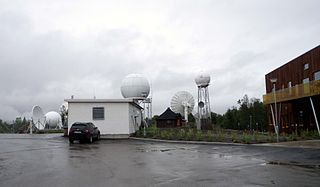
The European Space Operations Centre (ESOC) serves as the main mission control centre for the European Space Agency (ESA) and is located in Darmstadt, Germany. ESOC's primary function is the operation of unmanned spacecraft on behalf of ESA and the launch and early orbit phases (LEOP) of ESA and third-party missions. The Centre is also responsible for a range of operations-related activities within ESA and in cooperation with ESA's industry and international partners, including ground systems engineering, software development, flight dynamics and navigation, development of mission control tools and techniques and space debris studies.

Kiruna is the northernmost town in Sweden, situated in the province of Lapland. It had 17,002 inhabitants in 2016 and is the seat of Kiruna Municipality in Norrbotten County.

Esrange Space Center is a rocket range and research centre located about 40 kilometers east of the town of Kiruna in northern Sweden. It is a base for scientific research with high-altitude balloons, investigation of the aurora borealis, sounding rocket launches, and satellite tracking, among other things. Located 200 km north of the Arctic Circle and surrounded by a vast wilderness, its geographic location is ideal for many of these purposes.

The Swedish Institute of Space Physics is a Swedish government agency. The institute's primary task is to carry out basic research, education and associated observatory activities in space physics, space technology and atmospheric physics.

New Norcia Station is an ESTRACK Earth station in Australia for communication with spacecraft after launch, in low earth orbit, in geostationary orbit and in deep space. It is located 10 kilometres (6.2 mi) south of the town of New Norcia, Western Australia. It was the first ESA deep space ground station, followed by Cebreros Station and Malargüe Station.

The European Space Astronomy Centre (ESAC) is the ESA's centre for space science. It hosts the science operation centres for all ESA astronomy and planetary missions together with their scientific archives. Past and present missions represented at ESAC include Akari, BepiColombo, Cassini–Huygens, Cluster, Exomars, Gaia, Herschel, Hubble, ISO, INTEGRAL, IUE, LISA Pathfinder, Mars Express, Planck, Rosetta, SOHO, Venus Express, and XMM-Newton.

The European Space Research Organisation (ESRO) was an international organisation founded by 10 European nations with the intention of jointly pursuing scientific research in space. It was founded in 1964. As an organisation ESRO was based on a previously existing international scientific institution, CERN. The ESRO convention, the organisations founding document outlines it as an entity exclusively devoted to scientific pursuits. This was the case for most of its lifetime but in the final years before the formation of ESA, the European Space Agency, ESRO began a programme in the field of telecommunications. Consequently, ESA is not a mainly pure science focused entity but concentrates on telecommunications, earth observation and other application motivated activities. ESRO was merged with ELDO in 1975 to form the European Space Agency.

EISCAT operates three incoherent scatter radar systems, at 224 MHz, 931 MHz in Northern Scandinavia and one at 500 MHz on Svalbard, used to study the interaction between the Sun and the Earth as revealed by disturbances in the ionosphere and magnetosphere. At the Ramfjordmoen facility, it also operates an ionospheric heater facility, similar to HAARP. Additional receiver stations are located in Sodankylä, Finland, and Kiruna, Sweden. The EISCAT Svalbard radar (ESR) is located in Longyearbyen, Norway. The EISCAT Headquarters are also located in Kiruna.
Perth Station was an ESTRACK Earth station in Australia, located at the Perth International Telecommunications Centre in the suburb of Cullacabardee. It has been retired from service in December, 2015 and has been replaced by the New Norcia Station.

Redu Station is an ESTRACK radio antenna station for communication with spacecraft. The station is located about one kilometre away from the village of Redu, Belgium. The ground terminals provide tracking capabilities in C band, L-band, S-band, Ku band, and Ka band as well as provide in-orbit tests of telecommunication satellites.

Cebreros Station is a European Space Agency, ESTRACK radio antenna station for communication with spacecraft, located about 10 km east of Cebreros and 90 km from Madrid, Spain, operated by the European Space Operations Centre and INTA. A 35-metre diameter antenna that receives and transmit in X- and Ka-bands is located at the site. Station code is "CEB". 20kW CW High Power Amplifier (HPA) it was created by Rheinmetall Italia SpA (Italy). The monitoring and control system was implemented by Microsis srl (Italy).

Maspalomas Station is an INTA-operated, ESTRACK radio antenna ground station for communication with spacecraft located at the southern area of Gran Canaria island, on the INTA campus. It is situated on the Montaña Blanca hill and is visible from the coastal resort of Meloneras, close to Maspalomas. It was originally established in the 1960s to support NASA's nascent human spaceflight program.

Kiruna Central Station is a railway station located on the Iron Ore Line in Kiruna, Sweden. The station is served by up to three daily services northwards on the Iron Ore Line to Narvik Station in Norway. Southwards, the station is served by two daily services to Luleå Central Station and Stockholm Central Station. All trains are operated by SJ.

Malargüe Station is a 35-metre ESTRACK radio antenna in Argentina. It enables the European Space Agency (ESA) to communicate with spacecraft in deep space. It is located 40 kilometres (25 mi) south of the town of Malargüe, Argentina. The Malargüe antenna has two sister stations, Cebreros Station, near Madrid, Spain, and New Norcia Station near New Norcia, Australia. The completion of this station allows ESTRACK to track deep space missions continuously.

Tromsø Satellite Station, until 1988 known as Tromsø Telemetry Station, is a satellite earth station located in Tromsø, Norway. The facility is owned by Kongsberg Satellite Services (KSAT), a joint venture between the Kongsberg Group and the Norwegian Space Centre (NSC). In addition to hosting its own antennas serving thirty satellites, TSS acts as the center-point of KSAT's operations and provides backbone services for the high Arctic Svalbard Satellite Station (SvalSat) and the Antarctic Troll Satellite Station (TrollSat).
Kourou Station is an ESTRACK satellite ground station in French Guiana. Two antennas are located at the site: A 15-meter one that receives in X- and S-bands along with smaller 1.3-meter X-band acquisition aid antenna. Additional facilities provide tracking, telemetry, telecommand and radiometric measurements.
Villafranca Station was an ESTRACK satellite ground station in Spain, 30 kilometres (19 mi) north from the city of Madrid in a Villanueva de la Cañada, within the area of European Space Astronomy Centre.
Santa Maria Island Station is an ESTRACK satellite ground station in Azores, 5 kilometres (3.1 mi) from the town of Vila do Porto on the island of Santa Maria.
The European Centre for Space Applications and Telecommunications or ECSAT is a research center belonging to the European Space Agency (ESA) and located in the Harwell Science and Innovation Campus in Oxfordshire, United Kingdom.



















